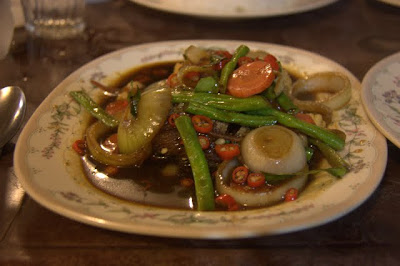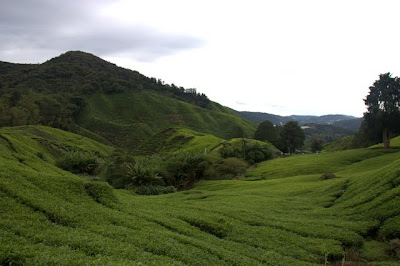Riders on the Storm: Two Weeks in Rainy Malaysia
The island of Langkawi in Malaysia is only an hour and half ferry ride away from Ko Lipe, Thailand. When we left Thailand, it was sunny and gorgeous. As soon as we crossed the border into Malyasia (which, by the way, was our third border crossing by water), we were greeted by the storm cloud above. And that’s pretty much how it went during our next two weeks in Malaysia.
The near constant rain, combined with our excitement to leave Asia behind and start a new adventure, meant that Malaysia didn’t get our full attention. We found Malaysia to be pleasant, but not overly exciting, probably half owing to our attitude at the time and the other half owing to Malayisia itself. Malaysia is the most developed country we visited in Southeast Asia, although there was no mistaking that we were still a long way from home. It also was sort of a culmination of our travels, reflecting religions, cultures and ethnicities we had encountered previously on the trip (the Cape Malay in South Africa, Indians in India, and Asians and Muslims in general).
It had been a long time since we encountered a country that is so ethically diverse. About half of the population of Malaysia are Malays, who, according to the Malaysian constitution, are Muslims who practice Malay customs and culture. The government grants certain non-Malay indigenous peoples such as ethnic Thais, Khmers, Chams and natives of Sabah and Sarawak a special “bumiputra” status. These citizens makes up 11% of the population and get certain rights other minorities do not have, such as the 23.7% percent of the population who are of Chinese descent and the 7.1% of the population who are of Indian descent. While the ethnic groups exist in relative harmony, they don’t mix much and there is resentment from the Chinese and Indians, many of whom have been in Malaysia for generations.
All of these ethnicities present in Malaysia means there is a broad array of architecture (including some with a British influence left over from the days Malaysia was a British colony) and most importantly, food. We struck out with our attempts to find delicious Chinese food (I’m sure it’s out there, we just stumbled upon a bad tourist restaurant when we were famished) but our reunification with Indian food did not disappoint, nor did our foray into Malaysian food. Maybe all of this variety means Malaysia is closer to home afterall.
Langkawi
Our quick two night stay on Langkawi, an island slightly more upscale than the backpacker havens we just left behind in Thailand, was mostly spent on the relatively affordable Cenang Beach, where we fit in a trip to the beach before we were rained out. Probably the most exciting thing that happened to us in Lankawi was our realization that we had spent two days living an hour in the past. We didn’t have a guidebook for Malaysia, and no one told us there was one hour difference in time between Thailand and Malaysia. The locals were just as confused as we were when we couldn’t figure out where the 2:30 ferry to Georgetown was. They kept telling us it left; we kept telling them that it couldn’t have because we were sitting at the terminal the whole time. Confusion ensued until we realized that oops, it was 3:30.
Georgetown
Georgetown is known for its UNESCO World Heritage buildings and multi-cultural food. We fit in a pretty good Indian meal and checked out the buildings around town before torrential downpours put an end to our exploration.
Perhentian Islands
We made a major detour over to Malaysia’s eastern coast because we heard the Perhentian Islands were fabulous and not to be missed. We spent 6 nights on Perhentian Cecil, the smaller, more developed island of the two. (More developed being relative, of course; the Perhentians are very low-key with just a sprinkling of locally owned restaurants and general type stores in shack-like buildings). Unfortunately (and I’m sounding like a broken record here, I know) we were plagued by storms again, making our decision to stay in a real concrete room at the relatively expensive Shari-La Resort instead of one of the cheap dilapidated shacks a good one. Perhentian Cecil is small. There’s not a lot to do except snorkel, dive, boogie board, and sun at the beach. We worked on our Advanced PADI scuba certification with Turtle Bay Divers while we were there. The weather progressively declined, but we were able to fit all of our required dives in. The constant runoff made the conditions were horrible – so much that we couldn’t even see our hands during our last dive, let alone any fish – which is a shame, because the diving is supposed to be amazing. This just means we’ll have to go back someday. Oh shucks, force me to go back to a beautiful lush tropical island with blue, blue waters. I just hope our return trip won’t require a speedboat ride where us and our luggage get soaked from the pounding rain and the boat is trying to outrun a giant wave about to overtake us on our way to shore. (By the way, March normally is well outside of monsoon season. All of the locals told us the weather was very unusual – just our bad luck).

Our most favorite meal in Malaysia - roti canai. Much different than the roti in India or Thailand, this roti is more fluffy and slightly sweet. Malays eat it for breakfast dipped in a spicy curry sauce.

Chicken paprik from Eawan's Restaurant, which was in rain-avoiding sprinting distance from our chalet in the back of Shari-la's resort. Good thing, too, because Eawan is super friendly and his food is tasty.

We stayed at Coral Bay mostly for its great sunsets, which disappointingly never came out in full force during our stay. Dinner on the beach was still enjoyable.

Gorgeous. (But also really rough, which necessitated us trekking up over the hill - sometimes with our scuba equipment - to board the dive boat from the calmer Coral Bay).
Cameron Highlands
Another highlight of our Malaysia travels was the irresistibly green Cameron Highlands. There are crops all over Cameron Highland’s higher elevations like hydroponic strawberries, but the one the Cameron Highlands is most known for is tea. The green blanket of tea bushes over rolling hills is a beautiful sight. We toured the BOH tea plantation and had a cuppa; chowed down on some tasty Malay and Indian food; and hiked through a mossy forest.

We loved the super cheap Indian/Malay restaurants lined up on the main road. We especially liked these ayom (rice pancake like things dipped in coconut milk).

Nasi Lemak, a Malay specialty. It is rice cooked in coconut milk, topped with a hot chili sauce, egg, sardines and cucumber.
Kuala Lumpur
With 1.4 million people, Kuala Lumpur is Malaysia’s largest city and it is also its capital. By the time we rolled into Kuala Lumpur, we were over Asia and ready for New Zealand. Sorry, KL, I’m sure you’re a great city, but you didn’t immediately engage us and so that was that. While we were there, we checked out Chinatown; went to KLCC Suria, a huge mall; and went to the viewing platform of the Petronas Twin Towers (a bit of a snore especially since they’ve already been topped and we’ve been there, done that).













